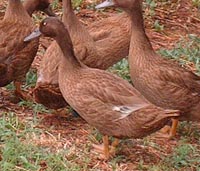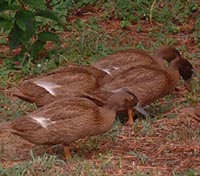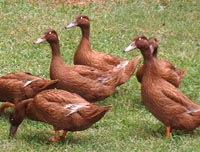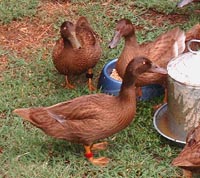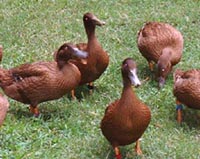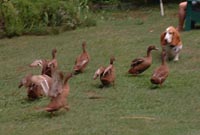
The ducks look like adults now. Their feathers are all in, and their wings, especially, have grown—as you can see in the photo. Most evenings before we herd them in for the night we let them wander around the yard, and they have started trying to fly. They will run across the yard, flapping their wings and hopping, and occasionally get a few inches off the ground.
They are turning into beautiful ducks. Each brown feather is tipped with white and their flight feathers are partly white, so that they provider a range of colors. From a distance they still appear solid brown, but the closer you look, the more beautiful they are. Until one of them craps on your shoe, anyway.
Growth and development
We are not sure what to expect from the flying. Domestic ducks, from everything we have read, are supposed to be essentially flightless, and I read one suggestion that a two-foot fence was sufficient to keep them in. So far, they do not seem capable of getting very far off the ground, but they aren’t nearly full-grown yet.
For a few weeks we thought that Sybil might turn out to be male. (We had, after all, one bonus duckling.) At about five weeks old, her bill starting turning greenish-yellow as drakes’ bills do. She is quieter than the others, too, and tends to hang back. But her bill has reached a steady greenish-brown color, and her feathers are hen’s feathers, although Kathy read somewhere that drakes don’t get brighter wing feathers until their adult coat, which won’t come in for another month or two. If I really cared, I suppose I would contact someone who would really know, but I am happy for now to watch and wait. If she turns out to be a drake, we’ll rename her Manuel and let her be useless.
We also noticed a pecking order emerging during the past few weeks. A few of the ducks, mainly Eddy and Saffy (who has grown from the smallest of the seven into a bossy little duck), follow the others and nip them on the tail. ("Goosing" rather than pecking is the word that comes to mind, actually.) But they stopped doing this within a week or two; I gather they have worked out what they needed to work out.
Feeding
They seem perfectly content with the Mazuri waterfowl breeder formula. We feed them 2 to 4 cups in the morning and 2 cups in the evening, depending on how much they eat on any given day and how much of their own food they find in the yard. We are supplementing this “duck chow” with a range of garden leftovers, including bolted lettuce and parsley, pea greens, and tough outer cabbage leaves. They seem to be delighted with all of it, though never as much as with the lettuce, which they will still eat out of our hands.
We have had to buy a bigger (5-gallon) waterer for their daytime grazing pen; they were going through 2 gallons by noon on hot days, and it has been hot lately.
Photos
Click any of the photos below for a larger image.
Movies
These movies were taken in mid-July, when the ducks were about eight weeks old.
Grazing (1:54)
Wandering around the yard, dabbling in the grass, and interacting with one another. The barking in the background is Toby chasing his tennis ball.
- small format for 56K modem (6.1 Mb)
First Flight (2:01)
Assembled clips of the ducks running back and forth stretching their wings, and finally taking off in a few brief flights.
- small format for 56K modem (3.6 Mb)
- large format for cable modem (11 Mb)
Feynman and Her Flock (1:25)
One of the most frequent questions we get from friends learning we have ducks is “How do the dogs get along with them?” Feynman is mildly interested, though not as much as when they were tiny. As you can see here, she gets along with them just fine.
- small format for 56K modem (2.7 Mb)
Toby and the Ducks (2:04)
Toby, meanwhile, ignores the ducks completely unless they get in the way while he’s chasing his ball…and then he just plows on through. Eddy sometimes nips him on the butt when he does this. (Poor Toby — he doesn’t get to be in charge of anybody. He’s the Omega Dog.) And he tends to get a bit disconcerted when they fly over his head, as anyone might. Otherwise, though, they all get along just fine.
Because it’s Toby, most of this video involves the tennis ball. You can watch him tracking the ball and sounding off when he finds the trail — his own basset hound version of fetch.
- small format for 56K modem (4.4 Mb)
